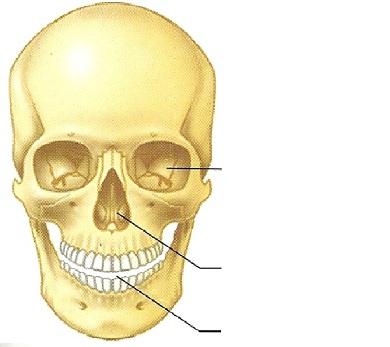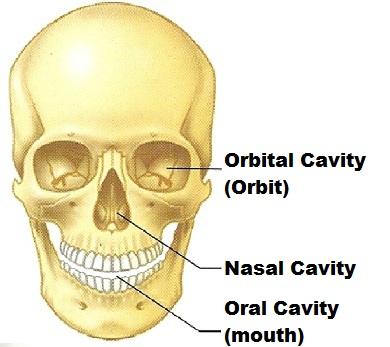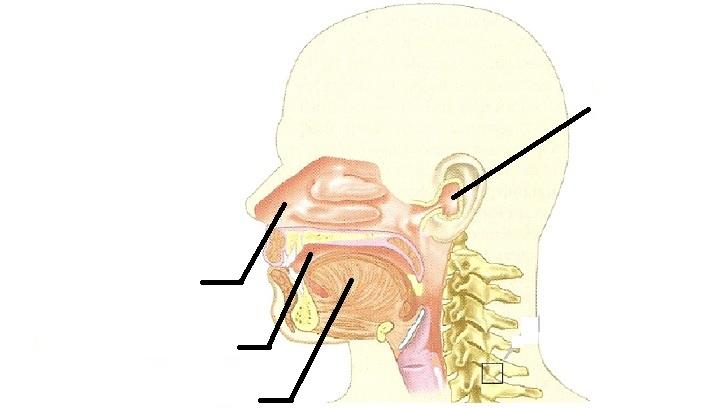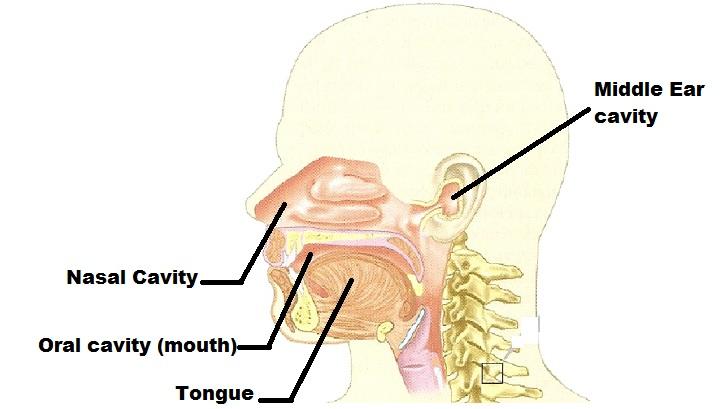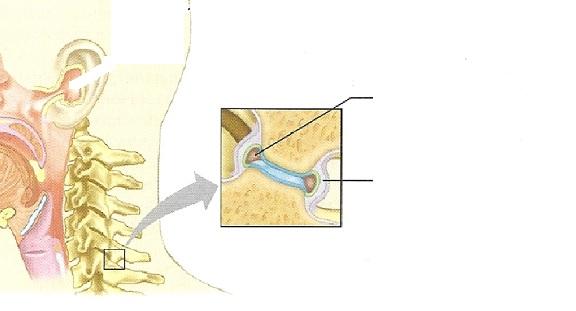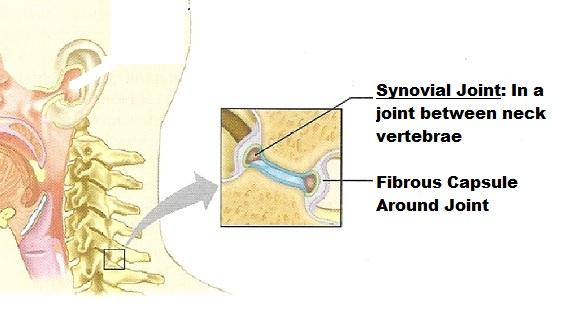gross anatomy
the study of body structures visible to the naked eye.
In the anatomical position the human body is
erect, with the feet only slightly apart, head and toes pointed forward, and arms hanging at the sides with palms facing forward
universally accepted standard position is called
anatomical position.
Axial
relating to head, neck, and trunk, the axis of the body.; Major Division of the body.
Appendicular
relating to limbs and their attachments to the axis.; Major Division of the body.
Abdominal
Pertaining to the anterior body trunk region inferior to the ribs.; Anterior Body Landmark
Acromial
Pertaining to the point of the shoulder.; Anterior Body Landmark
Antebrachial
Pertaining to the forearm.; Anterior Body Landmark
Antecubital
Pertaining to the anterior surface of the elbow.; Anterior Body Landmark
Axillary
Pertaining to the armpit; Anterior Body Landmark
Brachial
Pertaining to the arm; Anterior Body Landmark
Buccal
Pertaining to the cheek; Anterior Body Landmark
Carpal
Pertaining to the wrist; Anterior Body Landmark
Cephalic
Pertaining to the head; Anterior Body Landmark
Cervical
Pertaining to the neck region; Anterior Body Landmark
Coxal
Pertaining to the hip; Anterior Body Landmark
Crural
Pertaining to the leg; Anterior Body Landmark
Digital
Pertaining to the fingers or toes; Anterior Body Landmark
Femoral
Pertaining to the thigh; Anterior Body Landmark
Fibular (Peroneal)
Pertaining to the side of the leg; Anterior Body Landmark
Frontal
Pertaining to the forehead; Anterior Body Landmark
Hallux
Pertaining to the great toe; Anterior Body Landmark
Inguinal
Pertaining to the groin; Anterior Body Landmark
Mammary
Pertaining to the breast; Anterior Body Landmark
Manus
Pertaining to the hand; Anterior Body Landmark
Mental
Pertaining to the chin; Anterior Body Landmark
Nasal
Pertaining to the nose; Anterior Body Landmark
Oral
Pertaining to the mouth; Anterior Body Landmark
Orbital
Pertaining to the bony eye socket (orbit); Anterior Body Landmark
Palmar
Pertaining to the palm of the hand; Anterior Body Landmark
Patellar
Pertaining to the anterior knee (kneecap) region; Anterior Body Landmark
Pedal
Pertaining to the foot; Anterior Body Landmark
Pelvic
Pertaining to the pelvis region; Anterior Body Landmark
Pollex
Pertaining to the thumb; Anterior Body Landmark
Pubic
Pertaining to the genital region; Anterior Body Landmark
Sternal
Pertaining to the region of the breastbone; Anterior Body Landmark
Tarsal
Pertaining to the ankle; Anterior Body Landmark
Thoracic
Pertaining to the chest; Anterior Body Landmark
Umbilical
Pertaining to the navel; Anterior Body Landmark
Acromial
Pertaining to the point of the shoulder; Posterior body landmark
Brachial
Pertaining to the arm; Posterior body landmark
Calcaneal
Pertaining to the heel of the foot; Posterior body landmark
Cephalic
Pertaining to the head; Posterior body landmark
Dorsum
Pertaining to the back; Posterior body landmark
Femoral
Pertaining to the thigh; Posterior body landmark
Gluteal
Pertaining to the buttocks or rump; Posterior body landmark
Lumbar
Pertaining to the area of the back between the ribs and hips also the loin; Posterior body landmark
Manus
Pertaining to the hand; Posterior body landmark
Occipital
Pertaining to the posterior aspect of the head or base of the skull; Posterior body landmark
Olecranal
Pertaining to the posterior aspect of the elbow; Posterior body landmark
Otic
Pertaining to the ear; Posterior body landmark
Pedal
Pertaining to the foot; Posterior body landmark
Perineal
Pertaining to the region between the anus and external genitalia; Posterior body landmark
Plantar
Pertaining to the sole of the foot; Posterior body landmark
Popliteal
Pertaining to the back of the knee; Posterior body landmark
Sacral
Pertaining to the region between the hips (overlying the sacrum); Posterior body landmark
Scapular
Pertaining to the scapula or shoulder blade area; Posterior body landmark
Sural
Pertaining to the calf or posterior surface of the leg; Posterior body landmark
Vertebral
Pertaining to the area of the spinal column; Posterior body landmark
Superior/inferior
(above/below) These terms refer to placement of a structure along the long axis of the body. Superior structures always appear above other structures, and inferior structures are always below other structures. For example, the nose is superior to the mouth, and the abdomen is inferior to the chest.
Anterior/posterior
(front/back) In humans the most anterior structures are those that are most forward—the face, chest, and abdomen. Posterior structures are those toward the backside of the body. For instance, the spine is posterior to the heart.
Medial/lateral
(toward the midline/away from the midline or median plane) The sternum (breastbone) is medial to the ribs; the ear is lateral to the nose.
Cephalad/caudal
(cranial)/(toward the head/toward the tail) In humans these terms are used interchangeably with superior and inferior, but in four-legged animals they are synonymous with anterior and posterior, respectively.
Dorsal/ventral
(backside/belly side) These terms are used chiefly in discussing the comparative anatomy of animals, assuming the animal is standing. Dorsum is a Latin word meaning “back.” Thus, dorsal refers to the animal’s back or the backside of any other structures; for example, the posterior surface of the human leg is its dorsal surface. The term ventral derives from the Latin term venter, meaning “belly,” and always refers to the belly side of animals. In humans the terms entral and dorsal are used interchangeably with the terms anterior and posterior, but in four-legged animals ventral and dorsal are synonymous with inferior and superior, respectively.
Proximal/distal
(nearer the trunk or attached end/farther from the trunk or point of attachment) These terms are used primarily to locate various areas of the body limbs. For example, the fingers are distal to the elbow; the knee is proximal to the toes. However, these terms may also be used to indicate regions (closer to or farther from the head) of internal tubular organs.
Superficial/Deep
(external)/(internal) (toward or at the body surface/away from the body surface): These terms locate body organs according to their relative closeness to the body surface. For example, the skin is superficial to the skeletal muscles, and the lungs are deep to the rib cage.
A section is a ____.
Cut
When the section is made through the body wall or through an organ, it is made along an imaginary surface or line called a ______.
Plane
A plane that runs longitudinally and divides the body into right and left parts is referred to as a __________ __________.
Sagittal plane
A plane that runs longitudinally and divides
the body into right and left parts is referred to as a sagittal plane. If it divides the body into equal parts, right down the middle of the body, it is called a _________ or a ____________ ________________.
median, or midsagittal,
plane.
All other sagittal planes (that are not median) are referred to as ____________ ____________.
parasagittal planes.
A longitudinal plane that divides the body (or
an organ) into anterior and posterior parts is a?
Frontal plane: Sometimes called a coronal plane
A plane that runs horizontally, dividing
the body into superior and inferior parts.
transverse plane
When organs are sectioned along the transverse plane, the sections are commonly called ?
Cross sections
On microscope slides, the abbreviation for a longitudinal section (sagittal or frontal) is
l.s.
Cross sections are abbreviated as?
x.s. or c.s.
The axial portion of the body has two large cavities that provide different degrees of protection to the organs within them they are?
Dorsal Body Cavity, and Ventral Body Cavity
The Dorsal Body Cavity can be subdivided into 2 cavities that are continuous with each other they are?
Cranial cavity, in which the brain is enclosed within the rigid skull.
Vertebral (or spinal) cavity, within which the delicate spinal cord is protected by the bony vertebral column.
Because the spinal cord is a continuation of the brain, these cavities are continuous with each other.
Like the dorsal cavity, the ventral body cavity is subdivided what are they?
The Superior Thoracic Cavity: The heart and lungs, located in the thoracic cavity, are afforded some measure of protection by the bony rib cage.
Abdominalpelvic cavity: Although there is no further physical separation of the ventral cavity, some prefer to describe the abdominopelvic cavity in terms of a superior abdominal cavity, the area that houses the stomach, intestines, liver, and other organs, and an inferior pelvic cavity, the region that is partially enclosed by the bony
pelvis and contains the reproductive organs, bladder, and rectum.
The superior _________ cavity: is separated from the rest of the ventral cavity by the dome-shaped diaphragm.
thoracic
The cavity inferior to the diaphragm is often referred to as the ___________________ cavity.
abdominopelvic
The walls of the ventral body cavity and the outer surfaces of the organs it contains are covered with an exceedingly thin, double-layered membrane called the ____________, or __________ ______________.
serosa, or serous membrane.
The part of the membrane lining the cavity walls is
referred to as the _________ _______, and it is continuous with a similar membrane, the __________ __________, covering the external surface of the organs within the cavity.
parietal serosa; visceral serosa
These membranes produce a thin lubricating fluid that allows the visceral organs to slide over one another or to rub against the body wall without friction.
parietal serosa; visceral serosa
also compartmentalize the various organs so that infection of one organ is prevented
from spreading to others.
Serous membranes
the serosa lining the abdominal cavity and covering its organs is the ?
peritoneum
the serosa lining enclosing the lungs is the ?
pleura
the serosa lining around the heart is the ?
pericardium
The specific names of the serous membranes depend on ?
the structures they envelop
the abdominal surface (and the abdominopelvic cavity deep to it) into four approximately equal regions is called
quadrants.
These quadrants are named according to their relative position—they are?
right upper quadrant, right lower quadrant,
left upper quadrant, and left lower quadrant

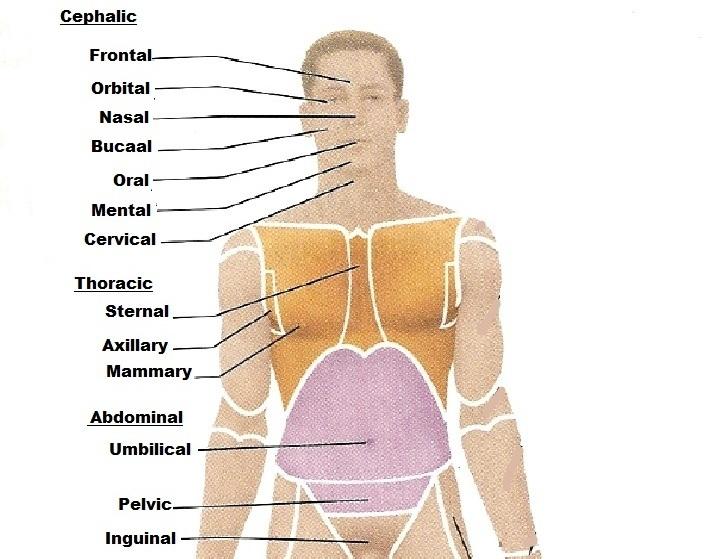
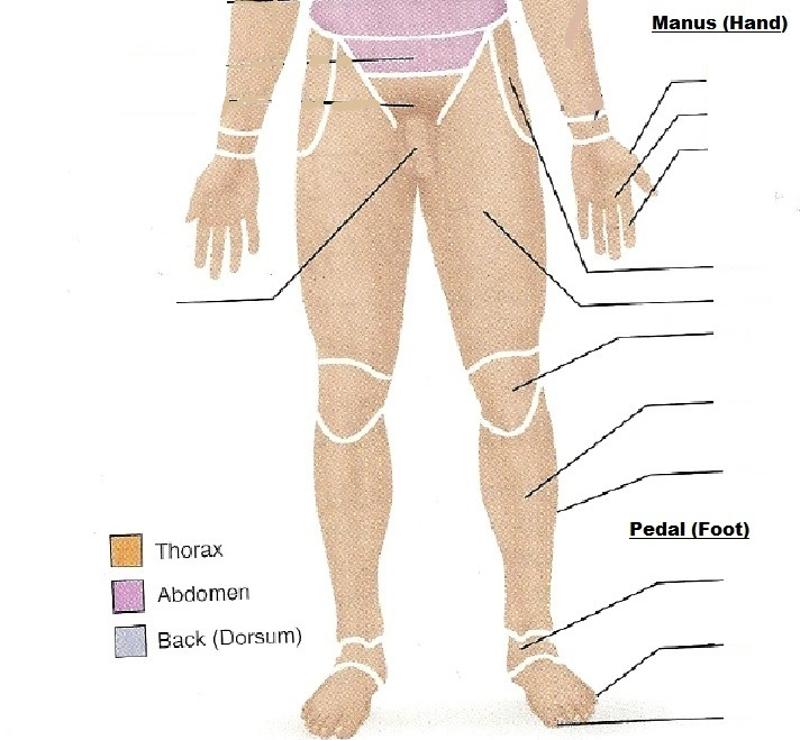
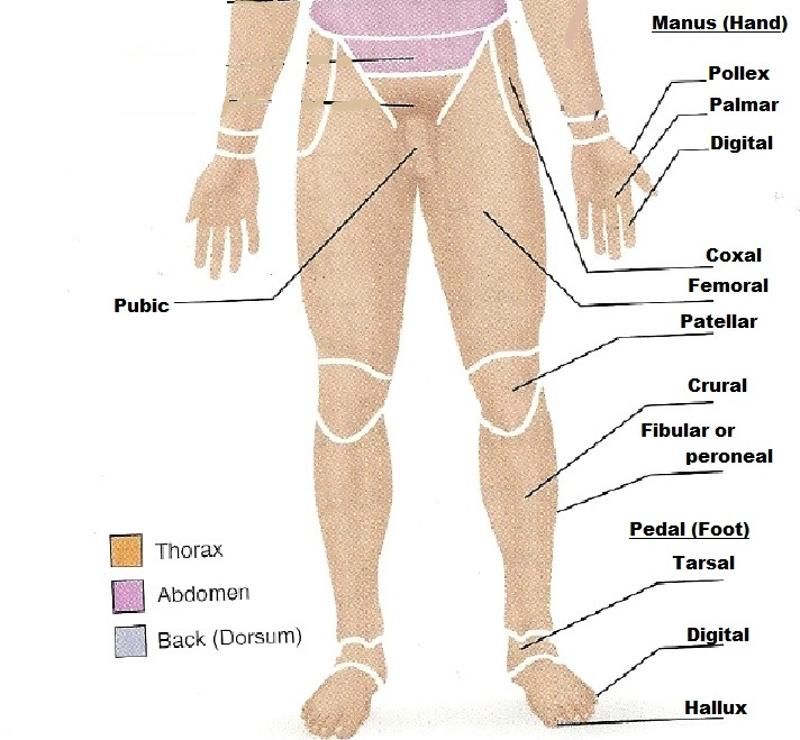
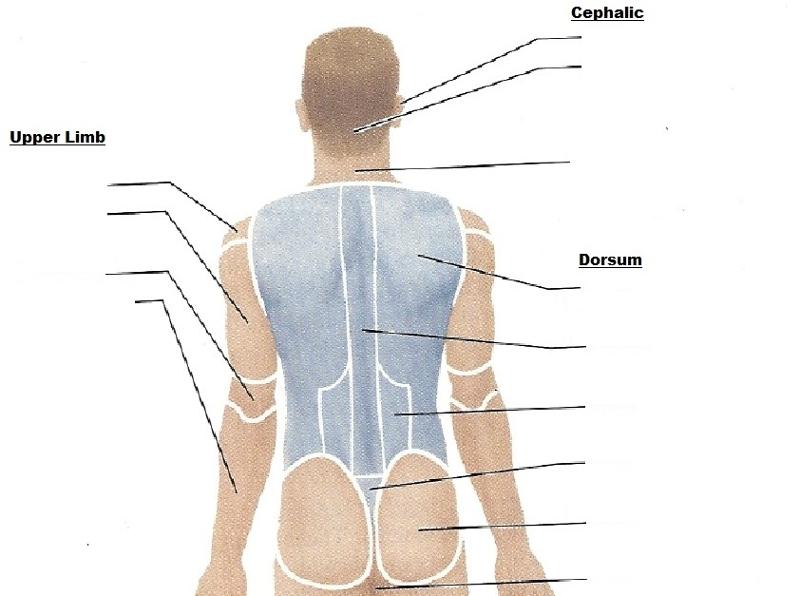
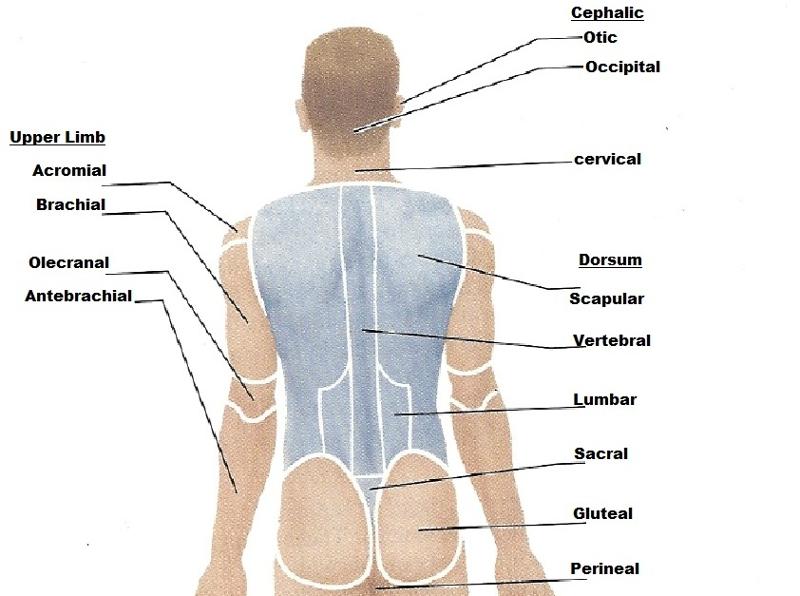
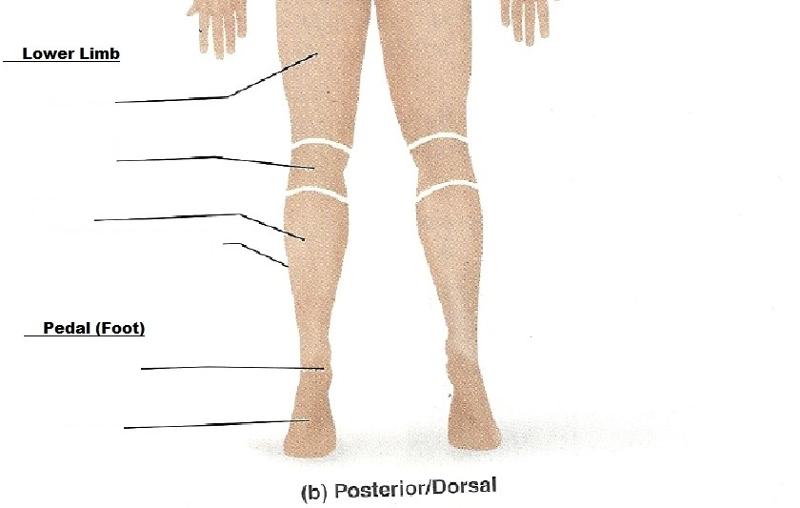

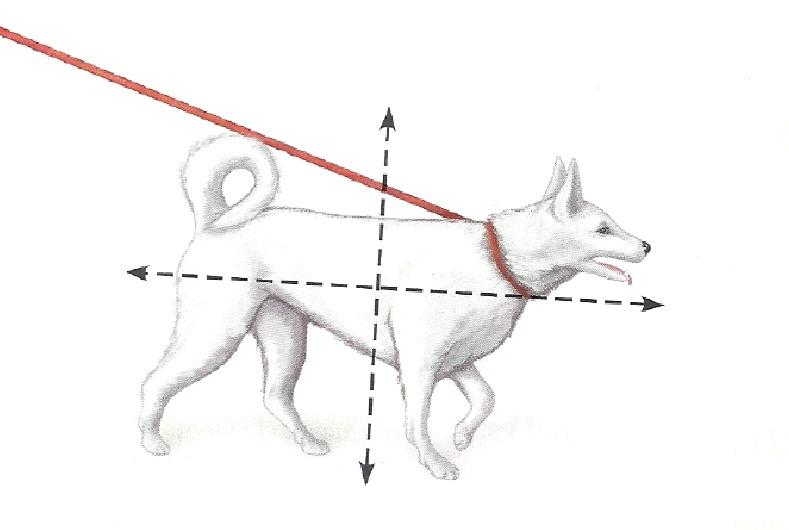
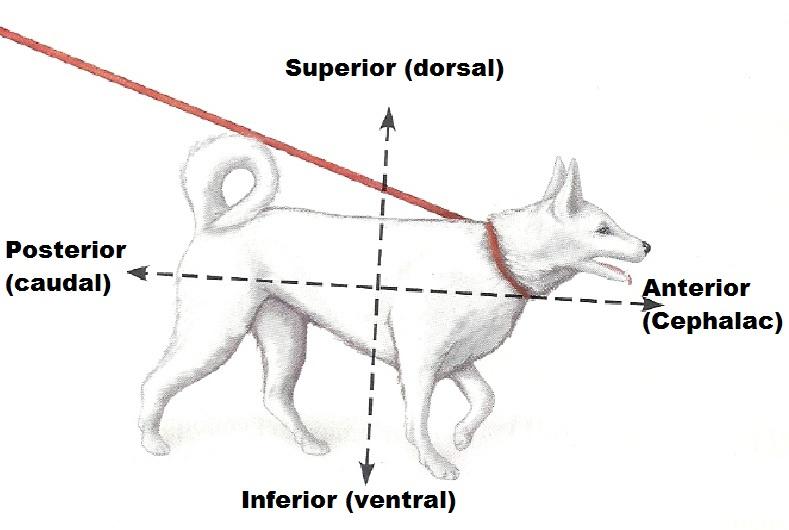
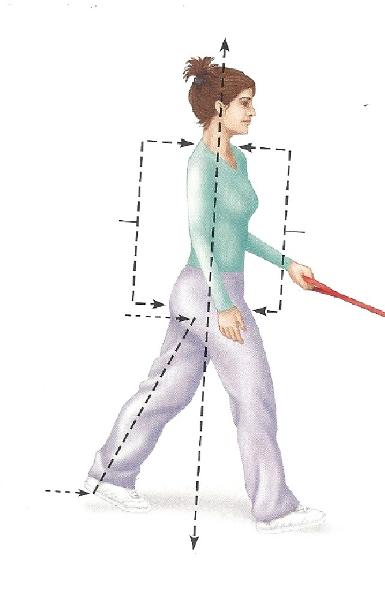
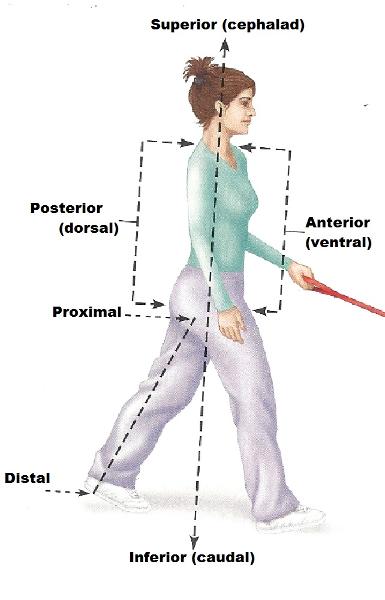

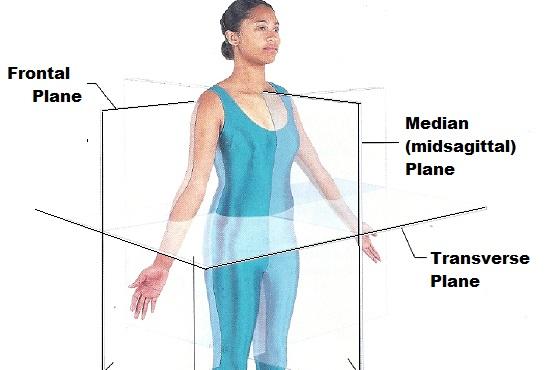

Frontal Section Through Torso
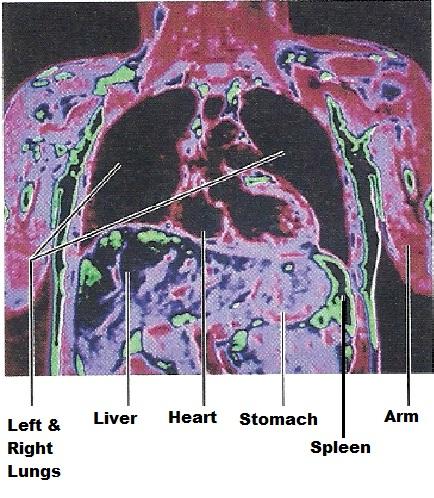
Frontal Section Through Torso
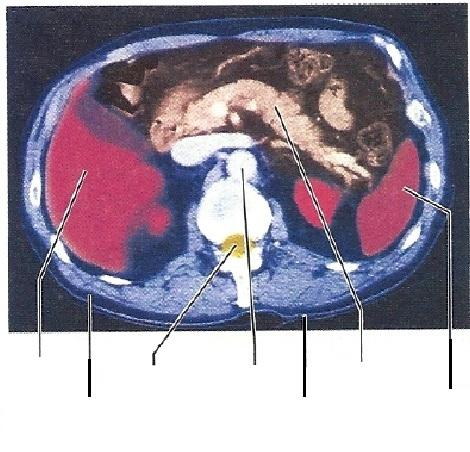
Transverse Section (Through Torso, Inferior View)

Transverse Section (Through Torso, Inferior View)

Median Midsagittal Section

Median Midsagittal Section
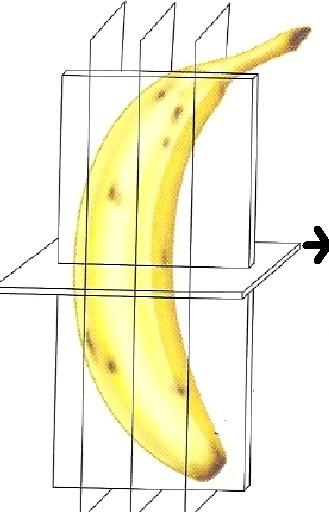

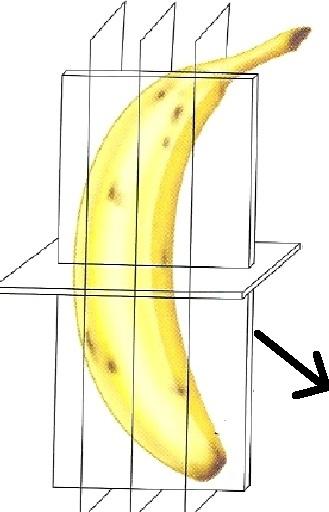
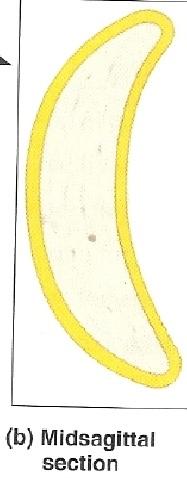
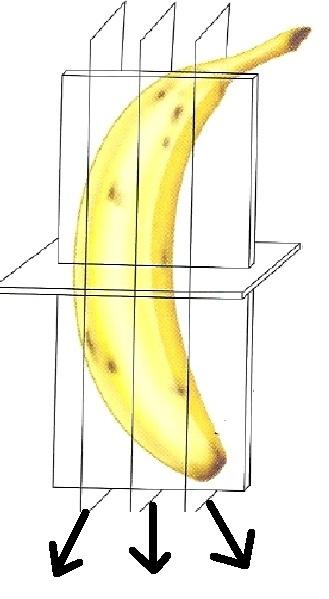
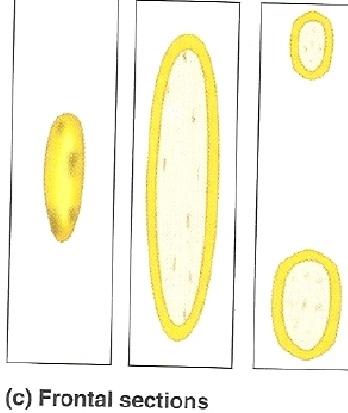
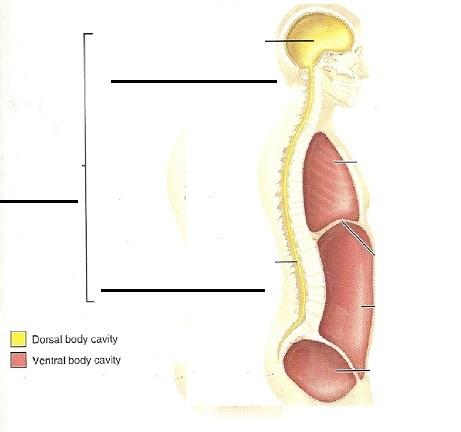
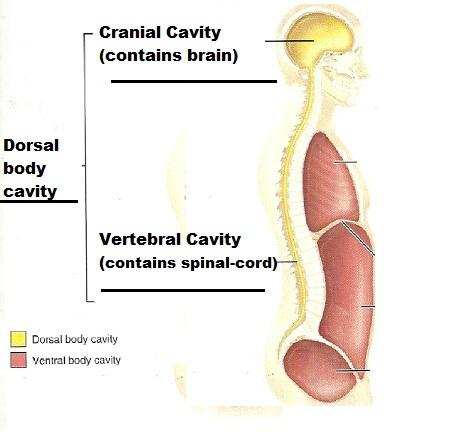
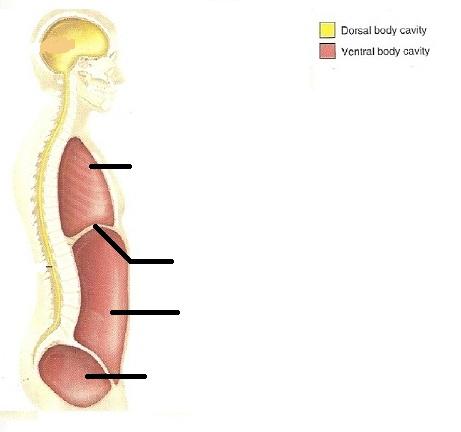
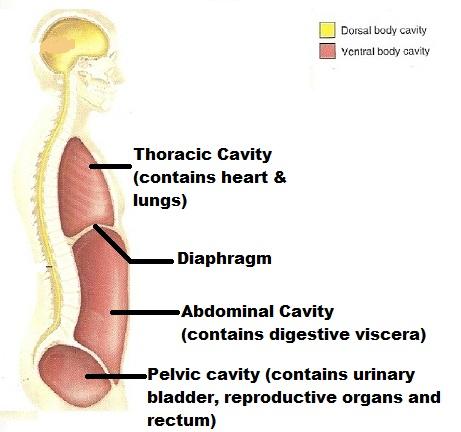
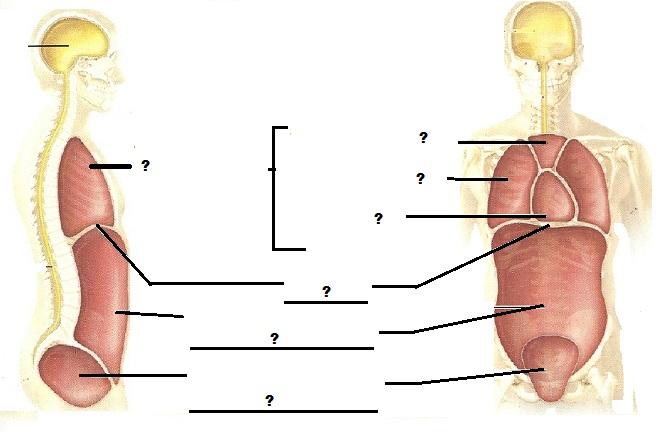
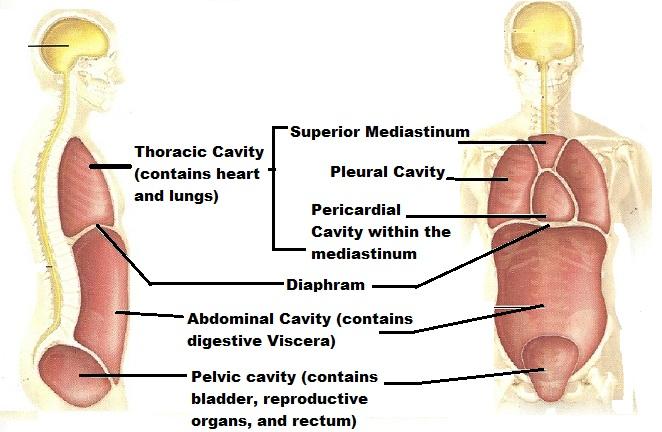
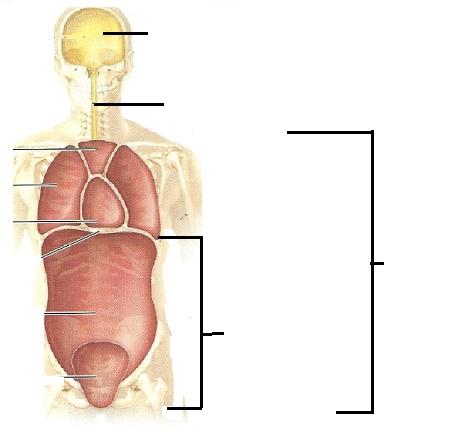
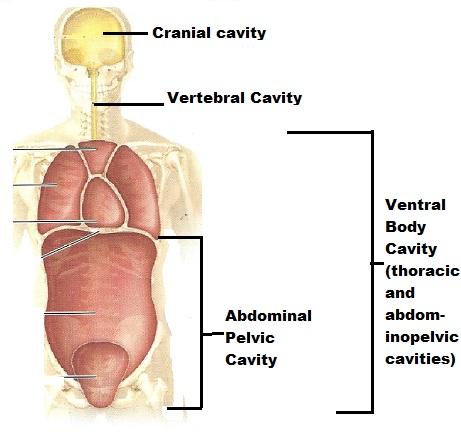
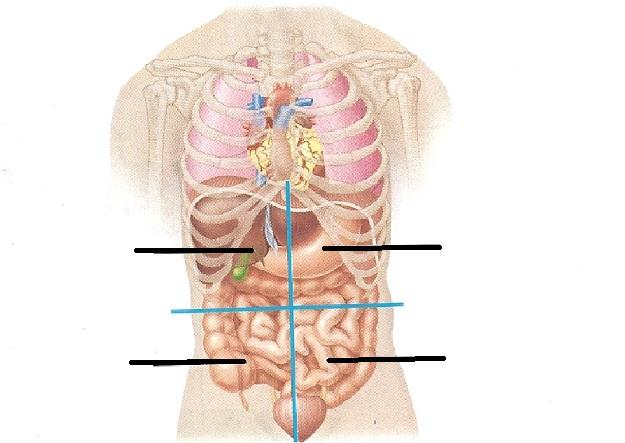
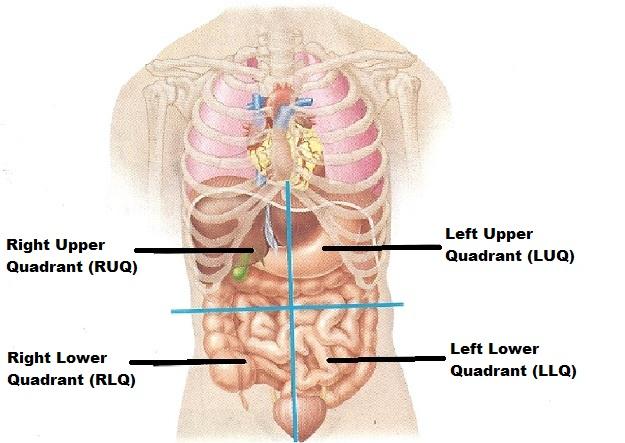
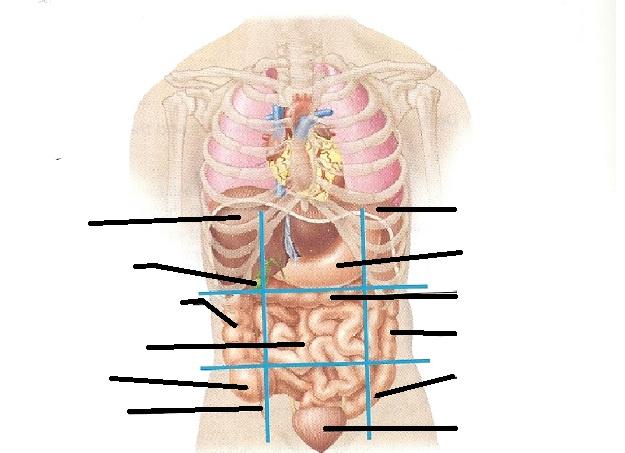
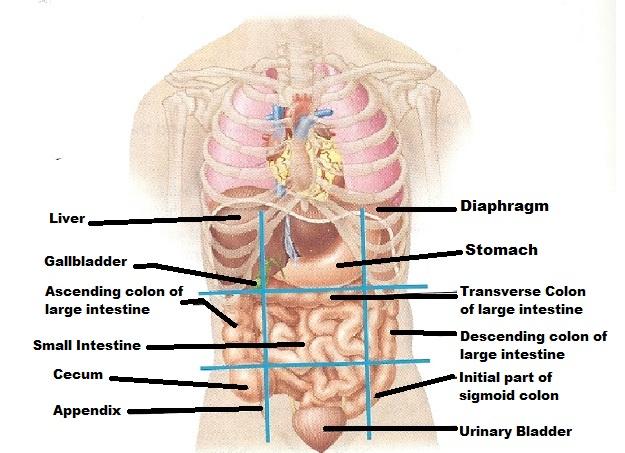
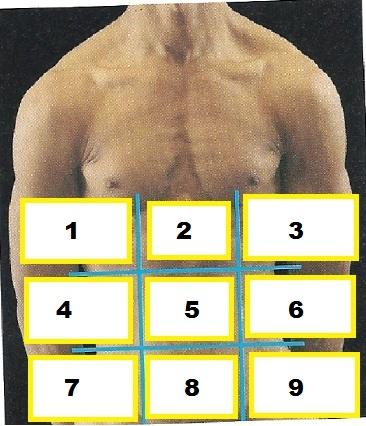
1. Right Hypochondriac Region
2. Epigastric Region
3. Left Hypochondriac Region
4. Right Lumbar Region
5. Umbilical Region
6. Left Lumbar Region
7. Right Iliac (inguinal) Region
8. Hypogastric (pubic) Region
9. Left Iliac (inguinal) Region
